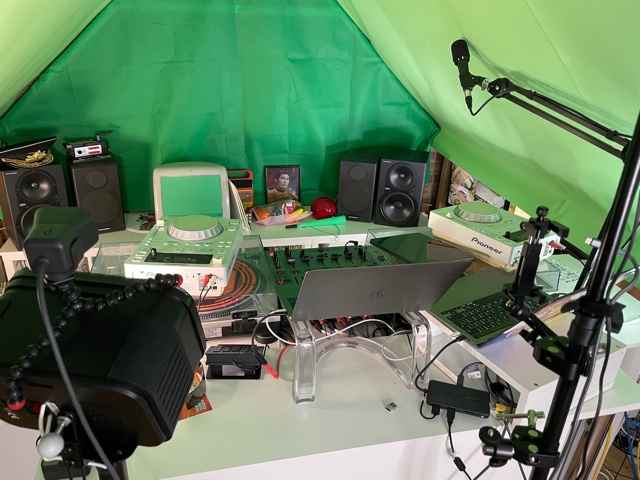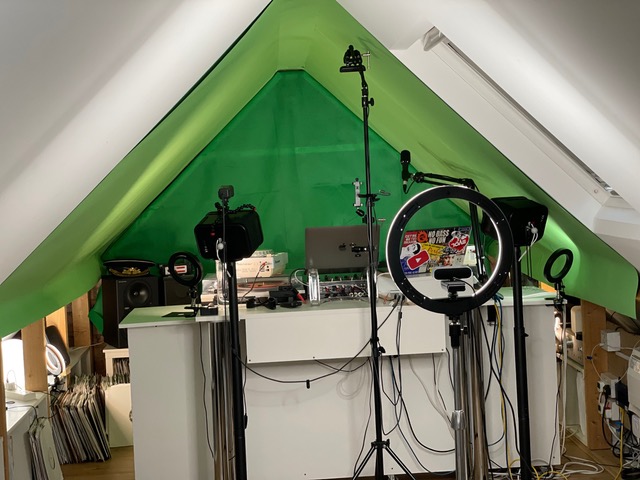Drum & bass icon John B was already leaning into the world of livestreaming before the pandemic hit. With his gigs drying up, the DJ/producer decided to dive head-first into the online world, challenging himself to create a regular streaming show that was totally different from anything else that was out there. The result? A bi-weekly drum & bass event that sees the DJ play in various settings, from the bridge of the Enterprise, to a flying Falkor, to the British Houses of Commons. All the while, a dancing Elon Musk, Bernie Sanders, and Joe Biden drop in and out of the interchanging backgrounds.
Streamed live on Twitch and subsequently reuploaded onto YouTube, it’s one of the most entertaining and visually stimulating online shows around. We caught up with the DJ veteran to find out how the setup works, and what boundless effort goes into producing it.
Hi John! At what point did you start streaming?
Twitch was already on my radar anyway. I’m not a big gamer, but there is this really challenging game called Escape from Tarkov on the PC, which I ended up watching YouTube videos about, of people explaining things… and most of them were Twitch streamers, so I wanted to know how that all worked.
This was just before late 2019. The last gig I did was when we were just starting to get worried about [the pandemic], and then initially I started panicking about it, and then thinking that this would be a nice enforced break.
The streaming gradually became my main focus. You can actually achieve good livestreams with just basic equipment. I’ve gone a bit overboard, and a lot of what I do is unnecessary. I’m just trying to make more of an effort and do something that looks unique and interesting.
I learned the OBS [Open Broadcaster Software] basics – the software you use for streaming. And simultaneously, I was learning more about Photoshop. I also knew Final Cut quite well, because I used it to do the video for a song of mine called ‘Get Stuffed’ (which was the precursor to a lot of my visuals). From there, I had to work out how to link everything together in OBS in a way that taxed the processor as least as possible. It’s working all right now, but I feel like I’m at the edge of what my hardware can handle.
How do you get everything to run seamlessly?
One of the things that was really helpful was a plugin called Advanced Screen Switcher for OBS. I have about 50 different scenes, and I can programme it to switch to a different scene after about 20 or 50 seconds. Most of it is just a cycle, so I don’t have to be constantly changing the visuals, which is important for me doing it on my own.
Did you already have a green screen?
You only need a green screen if you want to make what you have behind you invisible. I had a green screen beforehand because I needed one for the ‘Get Stuffed’ video. The thing that was causing me a problem was that my DJ setup is upstairs in my loft and the ceiling is triangular, so the green screen wouldn’t cover the ceiling bit in the front.
I then bought these huge rolls of green photographic card, and now the whole area behind me is now green, which wasn’t expensive to do.

What camera do you use?
I went through a lot of iterations of camera choices. At first I used my MacBook Pro 2016 – the laptop I used for DJing, running Serato and doing day-to-day stuff. It was pretty powerful, but it couldn’t it couldn’t meet all of the requirements I asked of it. I upgraded in June 2020 to the 13” MacBook Pro – but if you’re using an SLR, you have to run the HDMI out and use the El Gato Cam Link as a capture card. I bought one and tried it, and the frame rate was appalling. I’ve been wanting to get a Sony a6000 camera with a Sigma Lense, which is the streamers’ choice.
What I use now is my iPhone 12 Pro, using the OBS.camera app. It’s the best lens, when you compare it to webcams, but it does use an app to get through the USB, which I’m not a fan of. Occasionally I do get some digital blockiness on a few scenes, but I think that’s when OBS is struggling with a few things.
I also have a Logitech StreamCam, and a couple of Amazon specials. I use one overhead and then I have one in the distance, where it doesn’t matter that the pictures aren’t super clear. They run at a lower resolution, at around 720, so there’s less data flowing through my USBs.

My current issue is that I only have four USB-C ports on the MacBook Pro and sometimes after I finish a 2.5 hour stream with everything plugged in – including the iPhone and Stream Deck – the battery is almost drained to nothing. I’m hovering over whether to buy a PC at the moment.
What is a Stream Deck?
They’re made by Elgato, and are very popular among streamers. I’ve got three different ones. It’s like a display with loads of different buttons on it. You can program it so they can do lots of different things, but they work really well with OBS and people use them to trigger scenes. For instance, if someone calls in a rewind on a stream, I click a button and it plays the rewind stinger and sound effects. I’ve also started using it for Logic as well. It’s great for key commands and shortcuts, and has really improved my workflow.
How much effort do you put into your show graphics-wise?
Too much. I am always thinking of ideas for scenes, working out the assets – which means either masking out images of someone, or finding some rotoscoped footage of dancing people – and then getting them all together.
Most of my scenes consist of a background, my webcam placed somewhere, and something in front of me that serves as a table where my decks are on. The further on I go, the simpler I try to keep it, so there are less digital files that OBS has to read.
You also have these digital alerts that come through. For example, when someone follows me the Twitch API informs Streamlabs, who I’ve authorised to then create a custom alert that I’ve set up as a custom animation. You also have several logos that rotate, and show you can have your chat, although it’s not so necessary now that I’m only streaming on Twitch.
Is there a resource online for getting these rotarscope files?
There’s a few. I used Motion Array in the beginning. Now I use Envato, which is where I get all the random, dancing women in bikinis. There’s also a lot of stuff you can grab off YouTube. Quite often what I’ll do is find a place I want as the backdrop, and then to make it look like it’s moving more, I’ll cut out the sky and photoshop it, and put a video of clouds moving. Then I can have that fade away into mad VJ graphics. All that sort of VJ stuff is from Envato.
How is it monetized?
At the beginning a lot of people were setting up Patreons, but I just didn’t think that would work for me. So for me, I just hope that people will voluntarily support me – which is how Twitch and its community operate.
There’s a few ways of getting it to work. Subscribing is the first one people will look for. The really cool thing is that if you have an Amazon Prime account, you can do a Prime subscription. It doesn’t cost you anything extra, but the streamer will earn extra money from that. Then you just have to come back every month and reselect that.
Paid subscriptions have three different recurring tiers, which help you track how much money you’ll bring in per month. The other ways are through tipping using a Streamlabs system, and then there are Bits donations. If people tip me a certain amount, it can make me do certain things – like call a rewind, or play ‘Mr. Happy’ [DMinds, and DJ Hazard]. Things like that will keep people engaged. It’s also good to be active, be on the mic, and thank people when they do this. It really makes a difference.
Do you think you’ll bring any of this to a live club setting?
I’ve been wanting to do something new with my own bespoke visuals for a while. I’ve created visual assets that I can repurpose and I’ve been learning how I can do what I want live.
My plan is to take two laptops, one for my Serato and the other one to run the visuals, in a similar way to what I have for streaming, and have lots of individual set pieces that I can trigger live that will match with the audio that’s being heard in the club. I can take the audio out of the visual laptop into the DJ mixer, so when I’m triggering videos that have their own audio it will come through the speakers as well with my DJing stuff.
I have a big two-hour long cut background video with very little repetition which is quite rare in a club setting. Once I’ve created the long edit, which will be the base, then everything else will go on top of it. That’s how I’m planning on doing it: using OBS to output the visuals. That way, I can turn up to the biggest festival ever or the smallest club, take a HDMI plug in, and go. I won’t need to travel with any props or lighting rigs, and be able to do it with some cool interesting visuals and travel with it on my own.
As the world transitions back into one where shows become more commonplace, the touring veteran has shown how the pandemic can be beneficial. Now the tools to create dynamic and engaging livestreams, John B will be able to take what he’s learned to become an all-inclusive, AV act. Who says you can’t teach an old DJ new tricks?
You can keep up with John B’s livestream on Twitch.





